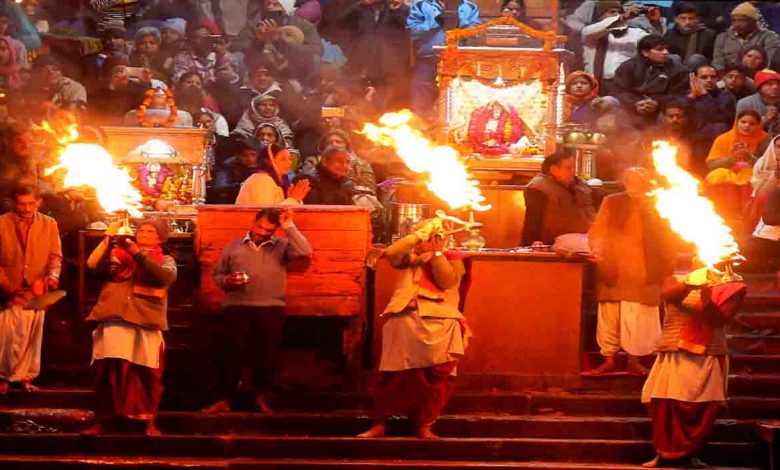Pathfinding in the Kumbh Mela

Monday, 05 April 2021 | Lokesh Ohri
HILLBILLY
 Lokesh Ohri
Lokesh Ohri
The Haridwar Mahakumbh is upon us and the event, for which every superlative possible in order to describe its size and expanse has been employed in the past, is being held this year under the shadow of a fresh Covid surge. The length of the celebration has been curtailed, and stringent checks are being made on the state borders to ensure the event does not spiral into a super-spreader. The Mela, nevertheless, continues to attract ever greater attention and remains a subject of intrigue, even as each edition contains within itself micro-narratives that redefine the Hindu tradition. Here are some interesting insights into the Kumbh tradition.
The Kumbh Mela, in its present form came about during British rule, who felt the need to regulate such a large congregation.The phrase Kumbh Mela and mention of the festival under its present name is missing in early Indian texts. However, the Indian tradition of communal bathing dates back to Indus Valley times as witnessed in the excavation of the Great Bath at Mohenjo-Daro. Several historical texts clearly reveal large, well-established bathing festivals at sites like Haridwar that were either annual or based on the twelve-year cycle of the planet Jupiter. Later Mughal era texts that contain the term Kumbh Mela in Haridwar’s context include Khulasat-ut-Tawarikh (1695–1699 CE) and Chahar Gulshan (1759 CE). An early account of the Haridwar Kumbh Mela was published by Captain Thomas Hardwicke in 1796 CE. The Mela at Haridwar, as a major bathing festival, in its earlier avatar was referred to as the Magh Mela.
The Haridwar Mahakumbh is held every twelve years. The twelve-yearly cycle has social and juridical significance as, according to the Hindu code, a person loses ownership rights over property if it remains unclaimed for over twelve years. The twelve-yearly cycle, therefore, is as much a reclaiming of space as it is a display of religious power. The Mahakumbh typically lasts for four months but has been curtailed to about a month this time. However, this is not the first time such an eventuality has occurred.
The colonial administrations too, often played around with the format and duration of the festival. During World War II, they banned the Kumbh Mela to conserve scarce supplies of fuel. The ban, coupled with rumours that Japan planned to bomb and commit genocide on the banks ofthe Ganga, led to sharply lower attendance at the 1942 Kumbh than prior Melas, where an estimated two to four million pilgrims usually gathered.
Most people limit their thinking of the Kumbh Mela in terms of the pomp, pageantry and politics of the Akhadas and the Naga Sadhus. The Akhadas definitely lend an element of interest to the celebration. An Akhada, in the Indian context refers to a sampradaya or sect, a group, a sub-unit or a military community, and a place for training, which is a monastery for religious renunciates in the Guru-Shishya tradition. Members of an Akhada train under a guru and they do not live a domestic or homely life. Some strictly practice Brahmcharya (celibacy) and others may completely renounce worldly life. Initially, there were only four Akhadas, which have split into subsidiary Akhadas due to differences in the leadership and expansion in the number of followers. There are about thirteen Akhadas now that are allowed to participate in the Kumbh and they have formed the Akhil Bharatiya Akhada Parishad with two representatives from each.
By the end of the 13th century, the tradition was well established. Adi Shankaracharya is believed to be the founder of seven major Indian Akhadas known as Mahanirvani, Niranjani, Juna, Atal, Avahan, Agni and Anand Akhadas, though the historical evidence for this is quite sketchy. The Akhadas are divided into four categories, the Sanyasi, Bairagi, Udasi and Kalpavasi.
By the end of the 16th century, coinciding with the Mughal invasions, Rajput warriors had begun to initiate peasants into arms training to provide services for resisting attacks on religious institutions.Nagas have a non-orthodox, semi-Tantric background, and were historically, particularly conspicuous when they served in the standing armies of various north Indian regents during the eighteenth century. During the latter half of eighteenth and early nineteenth centuries they were employed, in many instances as a regularly paid standing army, in service to Maharajas of Jodhpur, Jaipur, Jaisalmer, Bikaner, Udaipur, Baroda, Marwar (Western Madhya Pradesh), and Bhuj (capital town of Kacch).
In the general breakdown of law and order during the disintegration of Mughal authority, after the death of Aurangzeb in 1707, many groups of Sanyasis had organised themselves and began raiding the principalities. British records contain numerous reports of incursions by these armed groups, the first of which took place in 1743. Therefore, Naga Sadhus were often at the forefront of peasant unrest and rebellion against colonial repression and excessive taxation. Naga Sadhus are given some arms training, but generally their martial skills were those of offering themselves as sacrifice for the protection of dharma. The juniormost position of a sadhu of the Akhada is known as Huddanga. After three years of rigorous training, he rises to the position of Khiladi, followed by Rakmi and Nagapani. After a Nagapani attends all the Kumbh Melas of Prayagraj, Nashik, Haridwar and Ujjain and also becomes skilled in warfare, he is promoted to the rank of Nagateet, which is the highest position in the cadre of the Nagas. It takes twelve years for a sadhu to become a Nagateet. It is the Nagateets who provide training of wrestling, swordsmanship and warfare to the newly inducted Huddangas in any Akhada. They are also promoted to the ranks of Mahants and Shri Mahants in due course of time. A very few climb up to the rank of Jagadguru.
While the Akhadas and Naga Sadhus are a photographer’s delight in every mela, to my mind, the real substance of the Mela are the Kalpavasis, the ordinary village folk who come and stay the entire duration of the Kumbh and just be. They spend their time visiting camps, listening to discourses, participating in the cultural fair that the Kumbh automatically transforms into. The number of Kalpavasis is definitely going to be low this time, especially with restrictions and pandemic returning to some states. This should perhaps give the administration some respite and hopefully there will be no stampedes, that also have a habit of reoccurring every time, despite the best preparations by the administration.
Another aspect of this year’s Mahakumbh in the context of Haridwar’s Har-ki-Paidi, is that perhaps before the last snana is over, one will be able to see a completely restored Mansingh-ki-Chatri, midstream of the Ganga. The structure of this Chatri, built by Mansingh, the Raja of Amber in Mughal times, was altered earlier and has been under litigation since the 1980s. Only now the Uttarakhand High Court has directed INTACH (Indian National Trust for Art and Cultural Heritage) to restore the Chatri. In the previous Kumbhs, the administration decked it with flowers in order to conceal the unfinished eyesore. Work is being carried out at a quick pace to meet the deadlines.
The Kumbh has the magnetism to draw into its spiritual cauldron many monastics and saints who otherwise prefer to stay incognito. When such a variety of saints and sadhus come together, an assortment of views are exchanged and new wisdom is imbued for the general public, at least for those who come to learn.
The Mela in itself is like a huge convention of spiritual groups and Ashrams allowing everyone to check them out. The large tents become temporary dwellings for various spiritual sects and in some ways, it may seem like they are competing with each other for the attention of the public. They often use very loud public address systems with speakers pointed to the passers by on the road, or large and colorful gateways and facades attracting people into their camps. As soon as you get out of the range of one loudspeaker, you hear the next one. You can walk by the entrance and hear over the loudspeaker the lecture that’s being given inside. This may attract people who then go in and sit and listen to the lecture and possibly ask questions.
Wherever you go during the festival there is something spiritual to watch, listen to, or engage in. With all the activities, such as lectures, plays, bhajans, worship, and rituals that go on in the camps or at the sangam, along with the presence of highly learned and experienced sages and yogis, the Mela is a highly energised and spiritual event for one to attend. Furthermore, if you are volunteering to work in one of the camps, you will have plenty to keep yourself busy. There is always so much to do in serving the innumerable pilgrims who come through. But regardless of whether you are a serious pilgrim, businessman, teacher, student, housewife, or curious Western tourist, the Kumbh Mela is an event you will never forget. Perhaps, more than anything else, the Kumbh offers the opportunity to every seeker to look more closely at other doctrines and paths, some of which may open one to new ways of thinking, or for others, reassure one of the pathone is already taking.
(The writer is an anthropologist, author and activist who also runs a public walking group called Been There, Doon That?)





